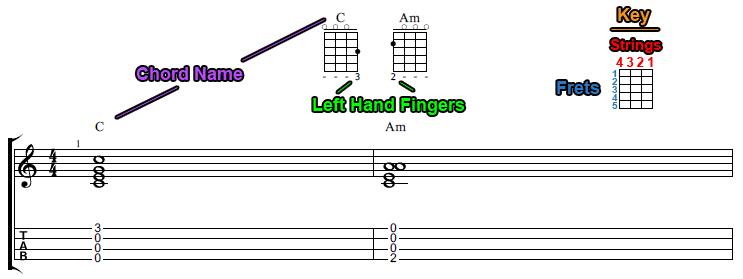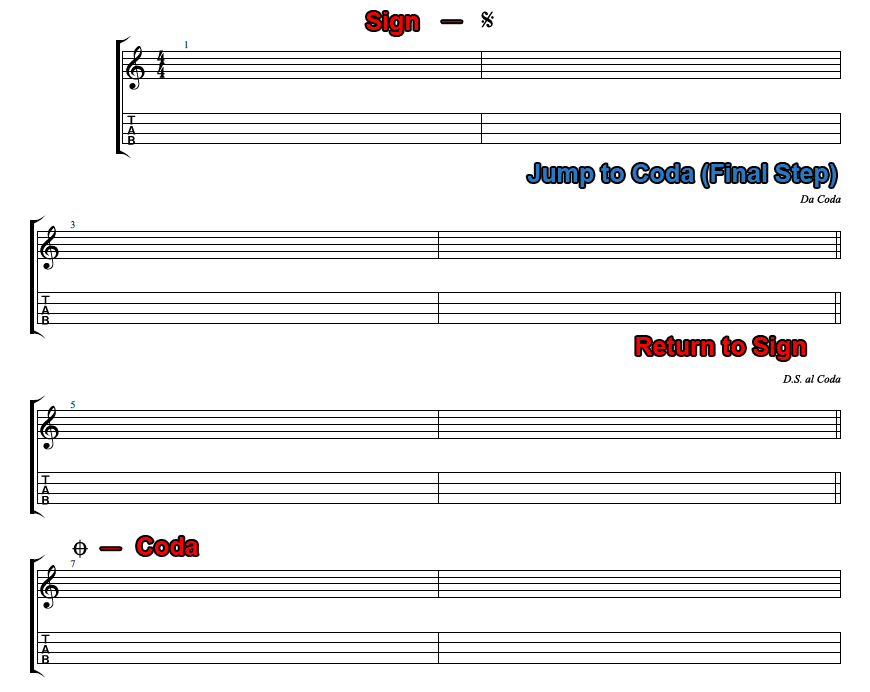How to Read Tabs, Chord Graphs, and Chart Symbols

There are three steps for reading tabs:
1) Which String to Play?
2) Which Fret to Play?
3) Which Left Hand Finger to Use?

The melody above is ‘Jingle Bells’.
Strings go horizontal, while frets are the numbers written on the lines. The numbers above the staff in green, are the left hand fingers you should use to fret the notes with.
We can see in Bar 1 that there are six ‘0’s on string 1. A ‘0’ means an open string. You will be playing:
The first string, open 6 times.
In Bar 2, we can see fret numbers on strings 1 and 2. You will be playing:
The first string, open.
The first string, fret three, with the third finger.
The second string, fret one, with the first finger.
The second string, fret three, with the third finger.
The first string, open.
Congrats! You just played your first melody on the ukulele!


The above represents a C Major chord and an A minor chord written in tab and chord graphs.
As we learned from above, in tab, single notes are represented by one fret number per string at a time. But, when we see more than one fret number stacked upon more than one string at a time, we have a chord.*
Take a look at the chord graph key. Strings are vertical, while frets are horizontal. Always begin reading from string 4, working your way to string 1.
To play the C Major chord:
String 4 is open.
String 3 is open.
String 2 is open.
Place your third finger on string 1, fret 3.
(Strum from string 4 down.)
To play the A minor chord:
Place your middle finger on string 4, fret 2.
String 3 is open.
String 2 is open.
String 1 is open.
(Strum from string 4 down.)
* Technically, chords are defined as three or more notes that are stacked by thirds and played / heard simultaneously.

Clefs, Signatures, & Tempo
Ukulele and guitar music is written in Treble Clef (?). The key signature (accidentals: sharps or flats representing the key the music is written in) always follows the clef sign. The time signature is placed immediately after the key signature at the beginning of a piece. Tempo indications are written above the upper staff.
In time signatures, the top number represents how many beats per measure to count, while the bottom number tells you what kind of note to count (for example: 2 = half notes; 4 = quarter notes).

Pauses
A fermata (or hold) is a sign, other than a rest, that indicates a pause. Fermatas appear as a crescent shape above the staff. It may apply to notes, rests, and occasionally, to bar lines.

Ties and Slurs
A tie is a gently curved arch connecting the heads of two notes of the same pitch. Ties indicate that the note should be played once and held for the length of the initial note’s value plus the connected note’s value.

A slur, while similar in appearance to a tie, connects notes of different pitches and indicates that the notes should be played independently, but smoothly. Slurs represent hammer-ons and pull-offs, which is also known as legato.

Dynamic Marks
Changes in tempo are always written above the staff. Ritardando (rit.) is a gradual decrease in tempo, while Accelerando (accel.) is a gradual increase in tempo.

Articulation Marks
Staccato: a small dot placed above or below the note head indicates shortening the value of the note by one half. Think of it as a quick hit, lacking sustain.

Repeat Signs
Double bar repeat signs call for the exact repetition of an entire section of work.

First and second endings indicate to play the music once, including the measure in the first ending, then repeat back to the opening repeat sign. Then, play the music a second time, and upon reaching the first ending, skip that measure and play the second ending.

Da Capo and Dal Segno
Da Capo (D.C.) means “go back to the beginning”; it is written above the staff.

Dal Segno (D.S.) means “go back to the sign”. The letters and sign are written above the staff.

D.C. al Fine means “go back to the beginning and play through to the measure marked Fine (end) and no further”.

D.S. al Fine tells you to “go back to the Sign and play through to the measure marked Fine”.

D.S. al Coda tells you to “return to the measure with the Segno sign, play as far as the Coda sign, and when you reach this point, jump directly to the Coda” and continue playing.

Article by: Andrew Hardel
